Planning your own trip? Prepare for your trip
Use Rough Guides' trusted partners for great rates
- Portugal
- Tomar
Book your individual trip, stress-free with local travel experts
Tomar is a small town on the Rio Nabão, close enough to Lisbon for a day trip but worth staying overnight. Its old quarter follows a grid of cobbled streets centered on Praça da República, with riverside walks and leafy woods for a slower pace. The real reason to come here rises above the town in the Convento de Cristo. Founded in 1160 as the headquarters of the Knights Templar, it is a fortress-monastery that tells the story of Tomar’s past. The Templars and townsfolk held off Moorish attacks in 1190, after which Tomar grew in wealth and influence alongside Portugal’s rise as a regional and later global power.

Tips from Luis
Portugal Travel Expert

Hi, I’m Luis, your Portugal travel expert, and Tomar is one of those towns that keeps pulling me back. It sits quietly on the Nabão River, but the sense of history here is anything but quiet. The Convento de Cristo towers above everything, a reminder that this was once the stronghold of the Knights Templar. The old grid of streets below is easy to explore on foot, with tiled façades, arcaded squares, and cafés that seem to slow time down.
You come for the convent, no question, but you stay for the rhythm of the town itself. Cross the stone bridge to the river park, wander into the shady gardens of the Mata Nacional dos Sete Montes, or just sit in Praça da República with a coffee and watch daily life unfold. Order a queijada de amêndoa if you want something sweet. It is Tomar in bite-sized form: simple, unpretentious, and rooted in tradition.
Luis’s tip
Skip the direct climb up to the convent and approach through the Mata Nacional dos Sete Montes instead. The woodland path is quieter, scented with pine, and when you finally reach the fortress walls, the view feels like a reward you have earned rather than one you simply bought with a ticket.
Best time to visit
Spring is one of the most enjoyable seasons in Tomar. The convent gardens burst into color, the weather is comfortably warm, and the town holds several cultural festivals. Autumn has a slower feel, with mild days that make walking around the town and up to the convent a pleasure. Summer can be hot, particularly at midday, though evenings by the river or in the town’s squares are lively and pleasant. Winter brings mist to the hills and a quieter atmosphere that makes the convent feel even more imposing.
How to get to Tomar
Tomar is easy to reach from Lisbon by train. Services leave from Santa Apolónia station and the ride takes about two hours. Driving is faster, around ninety minutes on the A1 and A23, which makes Tomar a simple day trip if you have a car. From Porto, the drive takes about two and a half hours, or you can take the train with a change in Entroncamento, which usually takes around three hours.
Best areas to stay in Tomar
Tomar is in central Portugal’s Ribatejo region, about 140 km north of Lisbon and 80 km south of Coimbra. The town stretches along the Nabão River, with the Convento de Cristo standing high above it on a wooded hill.
Often ranked among the best places to visit in Portugal, Tomar fits easily into a Portugal itinerary. It works as a rewarding day trip from Lisbon, or as a stop between the capital and the north. From here, you can detour to the island castle of Almourol on the Tagus, explore the peaceful village of Dornes, or make the short trip to Coimbra, home to one of Europe’s oldest universities.


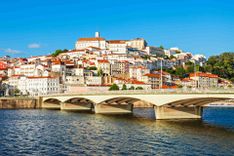


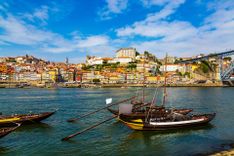










Tomar is compact and easy to explore, with most of the main sights within walking distance of the town center. The streets are flat near the river and Praça da República, but the climb up to the Convento de Cristo will test your legs. It is worth the effort for the views alone.
You can see the main sights of Tomar in a full day. Start with the Convento de Cristo, then work your way down into the old town for the Synagogue, Praça da República, and a walk along the Nabão. That itinerary gives you a good sense of the town without rushing.
If you stay overnight, the pace shifts. The streets grow quieter after dark, the convent is beautifully lit, and the cafés around the square are filled with locals rather than visitors. An evening in Tomar lets you enjoy the atmosphere that day-trippers miss.
If you have a longer, 10-day Portugal itinerary, two days here is ideal. Spend one inside the convent and old town, then use the second for nearby sights such as the island castle of Almourol or the lakeside village of Dornes. Having more time also means you can see Tomar at different hours, from misty mornings on the river to sunset views from the convent hill.

Entrance and main Church in the Convent of Christ (Convento de Cristo). Tomar, Ribatejo, Portugal © Andrei Nekressov/Shutterstock
Tomar has a good mix of small hotels, guesthouses, and rural escapes. Most are either in the historic center or along the river, with countryside stays just a short drive away. Here is where to base yourself depending on your style of trip.
Tomar is compact enough to see in a day but layered enough to reward a longer stay. At its heart is the Convento de Cristo, but the appeal runs far deeper: leafy gardens, medieval chapels, a remarkable aqueduct, and a town square that still feels lived in. Here are the best things to do in Tomar, each worth taking your time over.
The Convento de Cristo is Tomar’s headline act and one of Portugal’s most important historical sites. Founded in 1160 by Gualdim Pais, the master of the Knights Templar, it later became the headquarters of the Order of Christ, which financed Portugal’s voyages during the Age of Discoveries.
Inside, you move through centuries of architecture. The round Charola chapel, modeled on Jerusalem’s Church of the Holy Sepulchre, is covered in frescoes and gilded woodwork. Later cloisters reflect Gothic, Manueline, Renaissance, and even Baroque styles, each with its rhythm of arches and courtyards. The famous Manueline window, carved with ropes, corals, and fantastical creatures, is worth lingering over; it captures the optimism of a country looking out to the seas.
It takes at least half a day to do the site justice. Wear comfortable shoes, bring water in summer, and don’t rush. The convent’s scale and variety can overwhelm, so take breaks in the gardens, where orange trees and cypresses soften the fortress walls.
Tomar grew up along the Nabão River, and the Ponte Velha, built in the 16th century, remains its most atmospheric crossing. Standing midway, you see the town on one side and the convent rising above it on the other. The bridge leads directly to the riverside park, a quiet place for a shaded stroll or a picnic.
It is worth crossing at different times of day. In the morning, the convent glows in soft light. In the evening, the river reflects the town’s lamps and gives a sense of calm after the crowds leave. If you have time, sit on a bench along the riverside walk and just listen — you’ll hear church bells, kids playing, and the faint splash of ducks on the water.
This small building on Rua Dr. Joaquim Jacinto is easy to miss, but it carries enormous historical weight. Built in the mid-15th century, it is one of only a handful of medieval synagogues still standing in Portugal. Four stone columns support a vaulted ceiling, designed for perfect acoustics, and the small museum displays tombstones, inscriptions, and artifacts linked to the Jewish community.
Standing here, it is impossible not to think of the expulsion of Jews from Portugal in 1496 and the Inquisition that followed. Yet the synagogue’s survival adds another layer to Tomar’s story as a crossroads of cultures. It rarely feels busy, and if you step inside when it is empty, the quiet stone chamber has a contemplative power that rivals larger monuments.
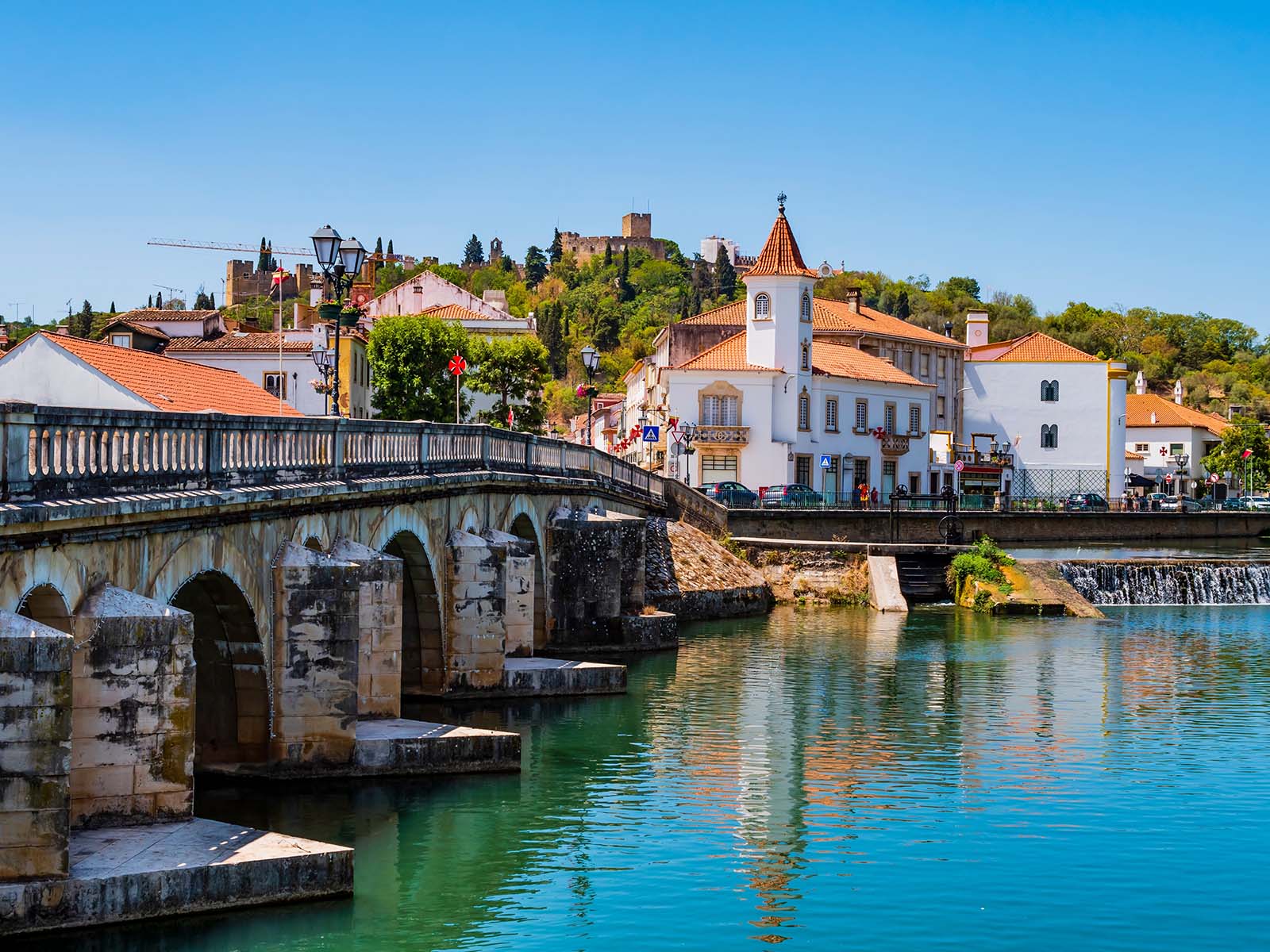
Old bridge (Ponte Vhela) over Nabao river, leading to the historic centre of Tomar © Shutterstock
Two kilometers from the town center, the Aqueduto dos Pegões is a masterpiece of Renaissance engineering. Built in the 16th century to carry water to the convent, it runs for nearly six kilometers and includes 180 arches, some reaching thirty meters in height.
You can walk along parts of the aqueduct, and the sense of balance and perspective as the arches march across the valley is extraordinary. From the top, the views stretch across olive groves, vineyards, and the rolling hills of the Ribatejo. Few visitors make it here, so you often have the place almost to yourself. Bring sturdy shoes and a head for heights if you plan to walk along the aqueduct wall.
This park spreads across 39 hectares between the town and the convent hill. Legend says the Templars once cultivated gardens here, and today it offers olive groves, cypress alleys, and shaded paths where you can escape the heat.
The walk from town through the Mata to the convent is one of the best ways to approach the monument. Instead of heading straight up the main road, you pass wells, terraces, and quiet corners where locals picnic. Stop at the Charolinha, a small circular temple in the middle of the gardens, which echoes the design of the convent’s round church.
Tomar’s central square is both a stage set and a lived-in meeting place. The Igreja de São João Baptista dominates one end, its Gothic tower a reminder of Tomar’s medieval roots. On the opposite side, the town hall occupies what was once the Templars’ palace.
Sit at a café terrace and watch the rhythm of daily life. You will see schoolchildren racing across the cobbles, elderly men chatting in the arcades, and the occasional busker setting up. If you visit during the Festa dos Tabuleiros, this square becomes the heart of the parade, filled with towering trays of bread and flowers. At other times, it is simply where Tomar breathes.
A short walk from the center, this church looks plain from the outside, but its history is extraordinary. Built in the 12th century, it was the burial place of the Knights Templar in Portugal, including Gualdim Pais, the town’s founder.
Inside, the Gothic arches are understated, the light soft, and the atmosphere hushed. Unlike the grandeur of the convent, this church has a simplicity that feels closer to the spirit of the Templars themselves. The surrounding cemetery, with its whitewashed tombs, adds to the sense of continuity with the past.
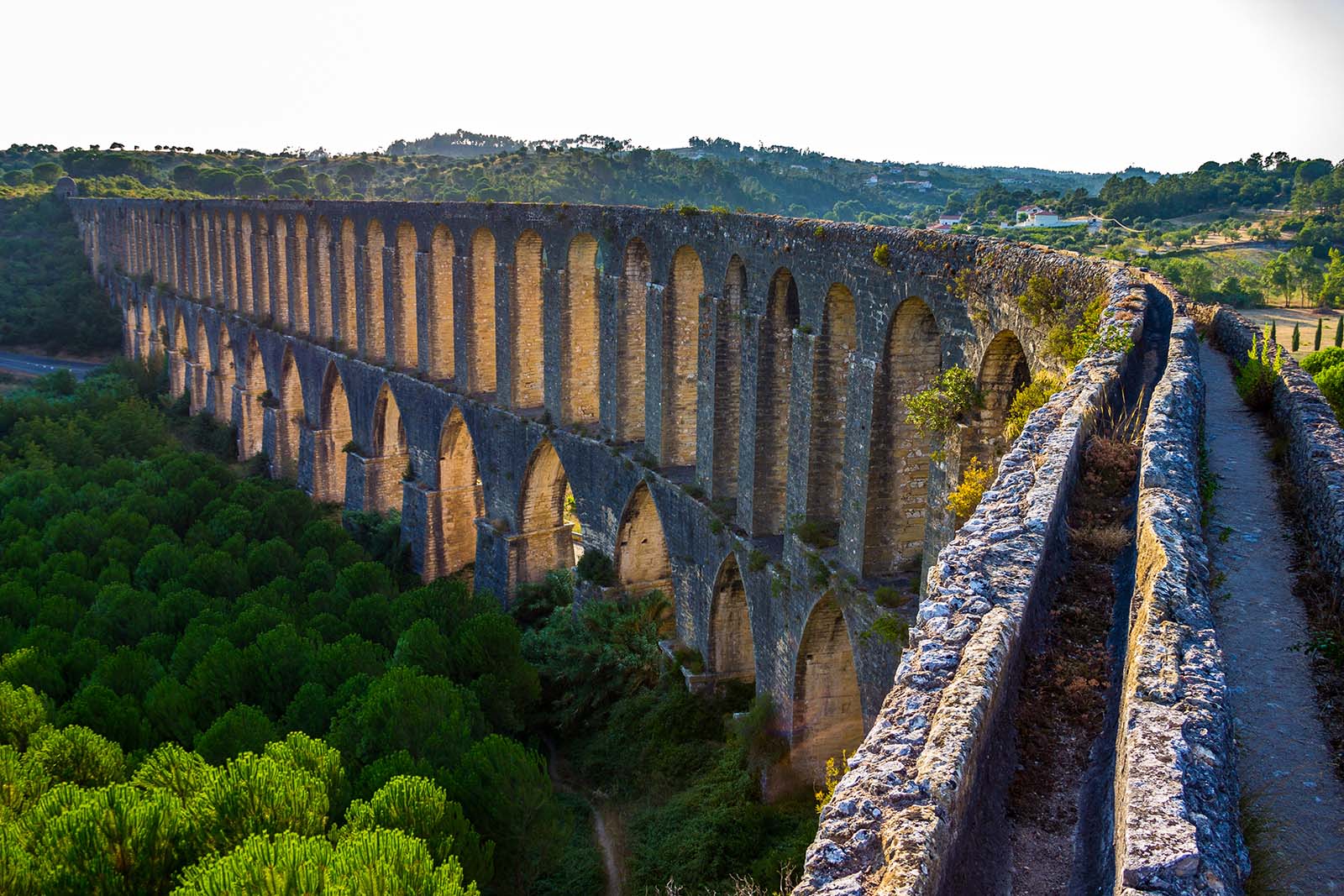
Aqueduct in Tomar, Portugal © Shutterstock
Every four years, usually in July, Tomar stages one of Portugal’s most striking festivals. Women parade through the streets carrying trays up to two meters high, stacked with bread and decorated with flowers, each weighing more than fifteen kilos. The event has medieval roots, linked to harvest rituals, and fills the town with color and music.
The festival draws thousands, so if you plan to visit at this time, book accommodation well in advance. Even if you miss the main parade, the preparations and decorations in the days before are fascinating in their own right.
Tomar’s tascas and restaurants offer hearty regional food. Expect dishes like roasted kid, migas made with bread and herbs, or river fish stews. The convent tradition of sweets lives on in queijadas de amêndoa, small almond tarts, and other pastries that pair perfectly with an afternoon coffee.
Meals are often slow affairs, and many restaurants are family-run. Ask about the house wine: it is usually a good, inexpensive red from the Ribatejo or nearby Tejo region.
About twenty kilometers away, Almourol Castle rises from a tiny island in the Tagus River. Rebuilt by the Templars in the 12th century, it looks like something straight out of a legend, complete with battlements and towers mirrored in the water.
You reach it by small boat, and once inside the walls, the views along the Tagus are unforgettable. The combination of history, setting, and sheer romance makes Almourol one of Portugal’s most atmospheric castles. Combine it with a riverside lunch in Constância for a perfect day out from Tomar.
Tomar has a Mediterranean climate with hot, dry summers and mild but wetter winters. Being inland, it sees bigger temperature swings than coastal cities such as Lisbon, though it is less extreme than mountain villages like Monsanto. Average temperatures range from 46°F (8°C) in January to 86°F (30°C) in August. The Nabão River helps cool summer evenings, but afternoons can feel intense. For current forecasts, check IPMA (Portuguese Institute for Sea and Atmosphere).
When you are deciding on the best time to visit Portugal, Tomar is at its most rewarding in spring and autumn. The weather is comfortable, gardens and parks are at their greenest, and the town is lively without being crowded.
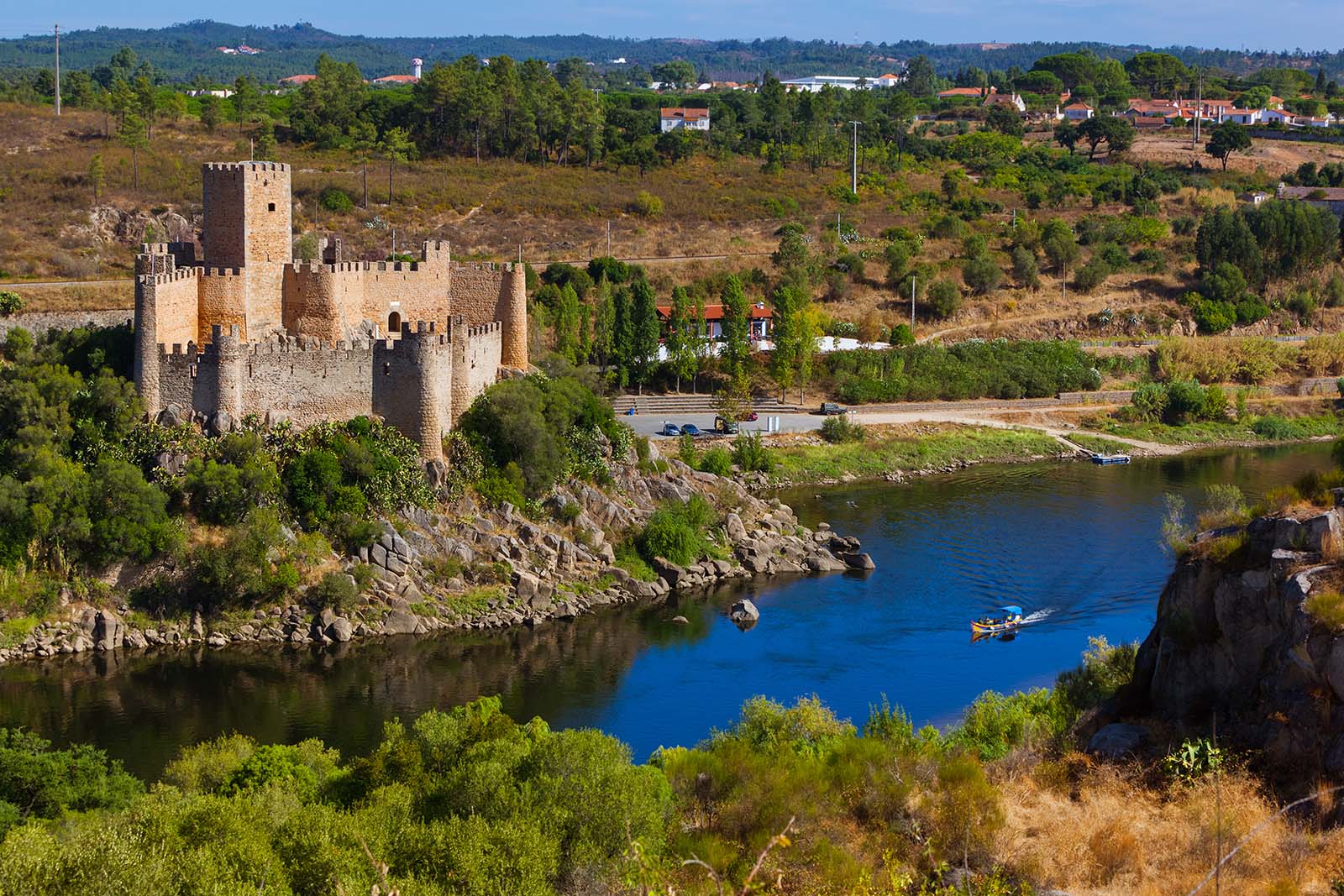
Almourol castle © Shutterstock
Tomar’s food scene balances hearty Ribatejo cooking with convent-inspired sweets and a few modern touches. Most restaurants are small, family-run, and tucked into the historic streets, though you’ll also find riverside cafés and rural taverns just outside town. Expect simple, filling meals: grilled meats, river fish, bread-based dishes, and pastries rooted in centuries-old monastic recipes.
Here are some unique experiences we can arrange for your tailor-made Tomar trip: all private, flexible, and designed by our local travel experts.
Discover Portugal's most captivating stories
Portugal Travel GuideUse Rough Guides' trusted partners for great rates
written by
Olga Sitnitsa
Online editor at Rough Guides, specialising in travel content. Passionate about creating compelling stories and inspiring others to explore the world.